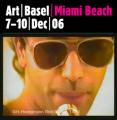 Art Video Lounge Art Basel Miami
Art Video Lounge Art Basel Miami
[PAM] is very proud to announce that the project has been chosen along with 17 featured video artists at Art Basel Miami Beach 2006.
«Art Video Lounge»: A new way to look at video art
curated by Michael Rush of the Rose Art Museum
The Art Video Lounge offers an extensive overview of video art. «Art Video Lounge» is open daily (December 6 to December 10) from 11 a.m. until 8 p.m. American curator Michael Rush has been entrusted with planning this year’s «Art Video Lounge». He has put together three programs: «Surrender to Illusion: Video in a Time of War», «Aesthetic Field: No Appropriation: Directors Direct/Performers Perform» and «In Brevitas Formositas: Short and Beautiful», 35 works by well-known artists and young talents are shown in an installation with nine screens as large projections. Visitors can also put together their own program from sixty additional works and view them on the available monitors. The program of contemporary video art has been curated by Michael Rush, Director of the Rose Art Museum. In tribute to the late Nam June Paik, who died last January, videos by the father of video art will also be shown every day. << ART VIDEO LOUNGE >> The Art Video Lounge and videotheque are located at the Botanical Gardens, across the street from entrance D of the Miami Beach Convention Center.
Opening Hours | Dec 6 – 9 | 11 a.m. – 8 p.m. Dec 10 | 11 a.m. – 6 p.m.
Art Video Lounge opening reception DEC. 6 11 a.m. - 12 p.m.
Video art emerged at a cultural moment in the 1960s marked by riots in the US and worldwide demonstrations of students and anti-war activists. It was also a time when artistic experimentation was heralding the collapse of the walls separating disciplines: dance, film, painting, sculpture, performance were yielding multimedia artworks that today are commonplace. As we celebrate the strong emergence of video as an international art phenomenon (video artists from the far reaches of the former Soviet Union, China, Africa, and throughout Latin America are regularly being seen at international exhibitions), we pause to both mourn and honor video’s pioneering artist and Miami resident, Nam June Paik, who died earlier this year. Artistic genius is defined, in part, by an inexplicable intuition about the zeitgeist that produces an art that changes forever the waywe see the world. Paik, touched by the experimental wizardry of Karlheinz Stockhausen and John Cage, knew that the technobox we call the television was itself radically altering the calculus of daily life; and rather than let it control him, he decided to dominate it: first as a material for sculpture, soon after as a meansof prophecy, using hundreds of monitors and thousands of images to mirror the televised, advertised, digitized world that now engulfs us.